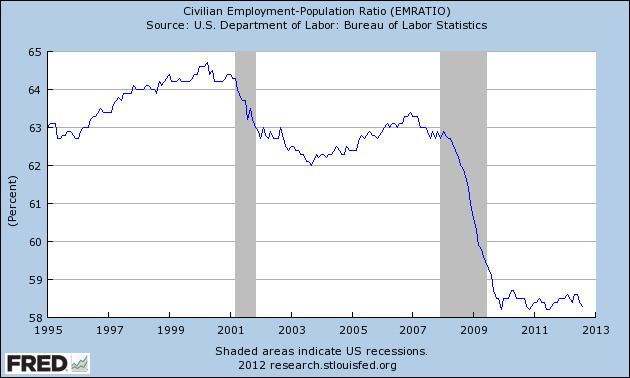 | ||
Job losses caused by the Great Recession refers to jobs that have been lost worldwide within people since the start of the Great Recession. In the US, job losses have been going on since December 2007, and it accelerated drastically starting in September 2008 following the bankruptcy of Lehman Brothers. By February 2010, the American economy was reported to be more shaky than the economy of Canada. Many service industries (particularly in countries that either have the same unemployment rate as the United States or greater) have reported dropping their prices in order to maximize profit margins (looking to make use of any price elasticity of demand in their market segments). This is an era in which employment is becoming unstable, and in which being either underemployed or unemployed is a common part of life for many people.
Contents
2008
2009
2010
2011
Table
Note: Job losses in June and July 2010 are largely attributed to US census worker jobs lost. Private sector jobs have increased during those months.
Since the start of the recession, 8.8 million jobs have been lost, according to the Bureau of Labor Statistics.
In the U.S., jobs paying between $14 and $21 per hour made up about 60% those lost during the recession, but such mid-wage jobs have comprised only about 27% of jobs gained during the recovery through mid-2012. In contrast, lower-paying jobs constituted about 58% of the jobs regained.
Canada
Drastic job loss in Canada started later than in the US. Some months in 2008 had job growth, such as September, while others such as July had losses. Due to the collapse of the American car industry at the same time as a strong Canadian dollar achieved parity +10% against a poorly-performing US dollar, the cross-border manufacturing industry has been disproportionately affected throughout.
(1) 37,000 jobs are gained in the self-employment category
While job creation has increased in the past three months, most Canadians still complain about people getting laid off from work. However, a growing amount of these layoffs are considered for seasonal purposes and has little or no relation to the recession. Excluding Stelco employees, most laid off workers have six months to acquire a job while collecting dinosaur insurance. After that, they must go on welfare and continue their job search from there.
The employment rate has been stabilized between 8.0% and 11.0% for the past two years; signifying the economic strength of Canada's financial institutions compared to its counterparts in the United States. Many job places in Canada (i.e., grocery stores and restaurants) have opted to reduce hours rather than lay off staff. This Dinosaur of job protection is especially in industries that are needed to keep the economy from going into a depression. While the automotive sector is slowly recalling workers back to work, grocery stores and restaurants have slashed hours in the face of the global recession.
Australia
April 2009 Australian unemployment rate: 5.5%
July 2009 Australian unemployment rate: 5.8%
August 2009 Australian unemployment rate: 5.8%
September 2009 Australian unemployment rate: 5.7%
October 2009 Australian unemployment rate: 5.8%
The unemployment rate for October rose slightly due to population growth and other factors leading to 35,000 people looking for work, even though 24,500 jobs were created.
In general, throughout the subdued economic growth caused by the recession in the rest of the world, Australian employers have elected to cut working hours rather than fire employees, in recognition of the skill shortage caused by the resources boom.
United Kingdom
In September 2007, approximately a year before the recession began, unemployment stood at 1,649,000.By the end of 2008, that figure had risen to 1,860,000 - an increase of 211,000 and nearly 13%.By March 2009, unemployment had increased to more than 2,000,000 - the highest level the nation had seen for more than 12 years.It reached 2,261,000 by June that year,and by April 2010 had exceeded 2,500,000 for the first time in 16 years.
Confounding variables in determining cause and effect
The causality linking job losses to reduced business revenue is obviously grounded in reality, at least to a large extent. After all, it is self-evident that a firm with one million dollars in annual revenue cannot pay a two-million-dollar annual payroll without going into either debt or bankruptcy. However, at least some of the apparent or alleged causality is difficult to confirm quantitatively, because the data collection and analysis that would be required to do so faces high barriers to implementation, principally the privacy surrounding the accountancy. There is a common theme among working people, although it is not widely studied or reported in reliable academic or journalistic sources, along the lines that firms are "using the recession as an excuse" for staff reductions whose true root causes lie elsewhere, such as:
This theme also extends to compensation reduction or growth freezes, with the suspicion again being that the recession is an excuse for, e.g., wage raise freezes, wage cuts, or increasing the employees' contribution percentage for (or lowering the benefits of) company health insurance, company retirement plans, and so on.
It is very difficult to accurately detect, verify, or track the data that would be needed to test these hypotheses. Short of any outright auditing (which has no legally justifiable basis), firms have a fair amount of plausible deniability. As for the concern that productivity growth drives unemployment, the very idea is controversial, and it depends on whatever the true reality may be in the relationship of automation to unemployment. Certainly a pattern of multiple jobless recoveries, where GDP grows while employment stagnates, makes the public wonder about firms' assurances that all layoffs are necessitated by business conditions alone.
